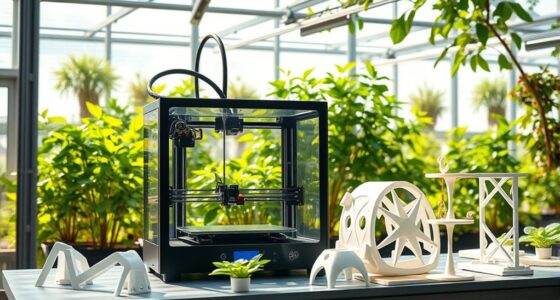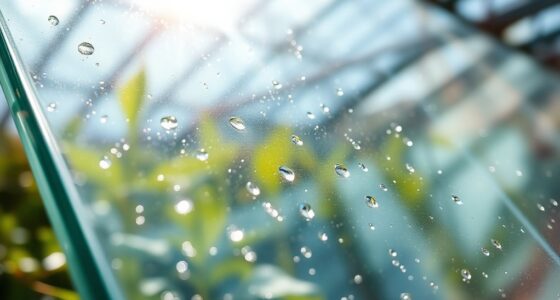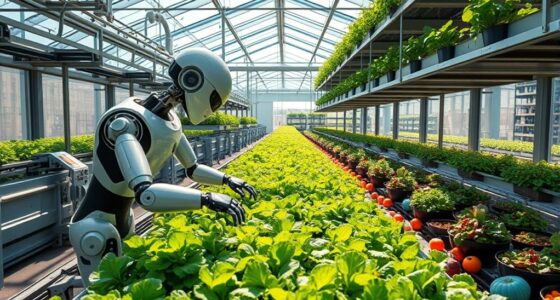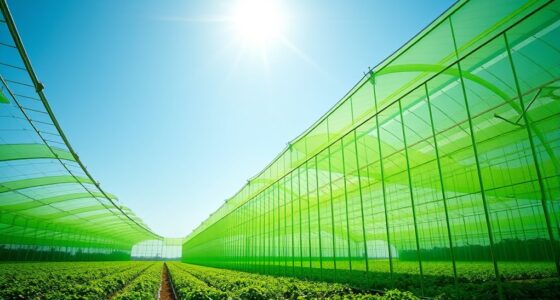To create a hydroponic system that practically runs itself, you can combine automated nutrient delivery with smart lighting controls. Use pre-mixed nutrient solutions, monitored and adjusted by sensors to maintain ideal EC and pH levels automatically. Pair this with LED grow lights that adjust intensity and schedule through timers or smart systems. This setup reduces manual work considerably, ensuring consistent growth conditions. If you want to learn how to set up such a seamless system, keep exploring the options available to you.
Key Takeaways
- Use automated nutrient dosing systems to maintain consistent nutrient levels and reduce manual adjustments.
- Implement smart lighting with timers or app controls for optimal, hands-free light schedules.
- Integrate sensors and controllers to monitor pH, EC, and water levels automatically.
- Choose modular, pre-plumbed systems designed for easy setup and minimal maintenance.
- Combine automation for both nutrients and lighting to create a nearly self-sustaining, low-maintenance hydroponic setup.

Hydroponic systems offer a modern and efficient way to grow plants without soil. They eliminate the need for traditional gardening methods, allowing you to cultivate healthy, vibrant plants indoors or in limited outdoor spaces. To succeed with hydroponics that practically run themselves, you need to pay attention to nutrient formulations and lighting enhancement. These two factors are the backbone of a low-maintenance, high-yield system.
Nutrient formulations are critical because plants rely on a precise mix of minerals dissolved in water, providing everything they need for growth. When you set up your hydroponic system, you should choose a balanced nutrient solution tailored to the specific plants you’re growing. Many commercial formulations come pre-mixed, making it easier to maintain consistent feedings. Regularly check the nutrient levels with a simple EC (electrical conductivity) meter or pH tester, ensuring the solution stays within ideal ranges. Automated dosing systems can help, adding nutrients at scheduled intervals, so you don’t have to manually adjust every day. This automation reduces guesswork and keeps your plants fed properly, leading to healthier growth with minimal intervention.
Lighting enhancement is equally essential because light governs photosynthesis, which is the engine of plant growth. With the right lighting setup, you can extend growing hours and ensure your plants receive consistent energy. LED grow lights are popular for their energy efficiency, customizable spectra, and longevity. To make your system almost self-sufficient, invest in lights with built-in timers or smart controls that adjust intensity based on the plant’s growth stage or time of day. Proper placement is key—hang lights at the correct distance above your plants and ensure even coverage to prevent uneven growth. Monitoring light levels with a PAR (Photosynthetically Active Radiation) meter can help you fine-tune your setup for maximum efficiency. When lighting is enhanced, plants grow faster and healthier, and you spend less time making adjustments.
Combining well-formulated nutrients with smart lighting controls creates a nearly autonomous hydroponic environment. Once you’ve dialed these in, your system can run with minimal oversight, leaving you free to enjoy gardening without daily hassle. Automated systems for nutrient delivery and lighting control are widely available, making it easier than ever to set and forget. As a result, you get consistent results and robust plants while spending less time on maintenance. This approach offers a sustainable, efficient way to grow fresh produce or lush greenery with very little effort, making hydroponics a perfect choice for busy or space-constrained growers.
Frequently Asked Questions
What Are the Initial Setup Costs for Automated Hydroponic Systems?
When considering the initial investment for automated hydroponic systems, you should expect startup expenses to be around $500 to $2,000, depending on the system’s size and complexity. These costs cover essential equipment like pumps, sensors, and controllers. Keep in mind, investing upfront can save you time and effort later, making automation a smart choice for consistent, low-maintenance gardening. Your initial setup costs set the foundation for successful growth.
How Much Daily Maintenance Do These Self-Running Systems Require?
Like tending a garden in your dreams, these systems demand minimal daily effort. You’ll spend just a few minutes managing plant nutrient levels and checking water quality, ensuring your plants stay healthy. System cleaning routines are infrequent, often requiring only weekly or biweekly attention. This simplicity lets you enjoy fresh produce without the hassle, making self-running hydroponic systems a perfect blend of automation and ease.
Can Automated Hydroponic Systems Grow All Types of Plants?
You might wonder if automated hydroponic systems can grow all types of plants. Generally, they support a wide plant diversity, but some growing techniques work better for certain crops. Leafy greens and herbs thrive easily, while root vegetables may need adjustments. With proper setup, these systems can handle many varieties, but understanding specific plant needs guarantees maximum growth and prevents issues.
What Are the Common Troubleshooting Issues Faced With These Systems?
You might face common troubleshooting issues like nutrient imbalance, where plants don’t get the right minerals, or pH fluctuation, which affects nutrient absorption. If you notice slow growth or leaf discoloration, check your nutrient levels and pH regularly. Cleaning your system and ensuring proper water circulation also help prevent problems. Staying vigilant and maintaining consistent nutrient and pH levels keeps your system running smoothly and your plants healthy.
How Energy-Efficient Are Fully Automated Hydroponic Setups?
Imagine a fully automated hydroponic setup using solar panels, drastically cutting power consumption. These systems are surprisingly energy-efficient, especially when paired with renewable energy sources like solar or wind. By optimizing lighting, pumps, and climate control, you reduce reliance on grid power, lowering overall energy costs. This eco-friendly approach not only saves money but also promotes sustainability, making your hydroponic farm both innovative and environmentally conscious.
Conclusion
So, with these almost self-sufficient hydroponic systems, you can finally sit back and pretend you’re a farming genius while barely lifting a finger. Who needs traditional gardening skills when your setup practically manages itself? Soon, you’ll be the proud owner of a lush, thriving garden, all without breaking a sweat—or learning how to actually garden. Just remember, if your plants start growing on their own, you might be doing more than just “letting technology do the work.”










